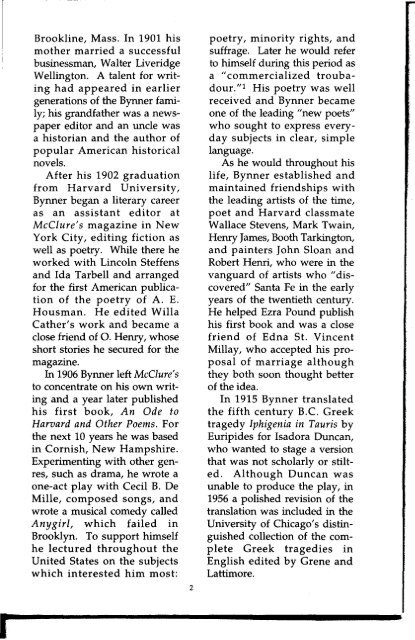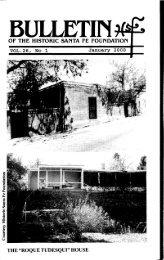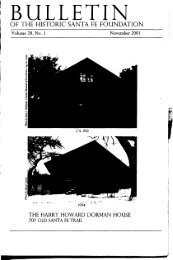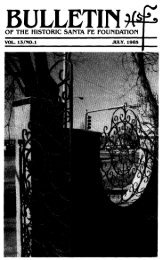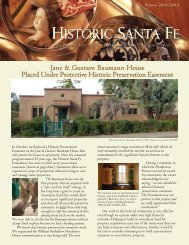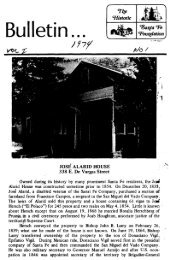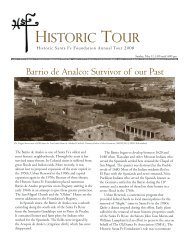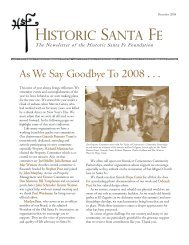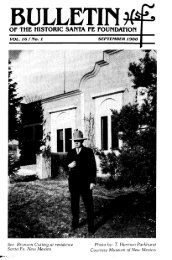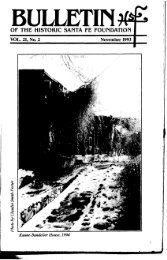Witter Bynner House - Historic Santa Fe Foundation
Witter Bynner House - Historic Santa Fe Foundation
Witter Bynner House - Historic Santa Fe Foundation
You also want an ePaper? Increase the reach of your titles
YUMPU automatically turns print PDFs into web optimized ePapers that Google loves.
Brookline, Mass. In 1901 his<br />
mother married a successful<br />
businessman, Walter Liveridge<br />
Wellington. A talent for writing<br />
had appeared in earlier<br />
generations of the <strong>Bynner</strong> family;<br />
his grandfather was a newspaper<br />
editor and an uncle was<br />
a historian and the author of<br />
popular American historical<br />
novels.<br />
After his 1902 graduation<br />
from Harvard University,<br />
<strong>Bynner</strong> began a literary career<br />
as an assistant editor at<br />
McClure's magazine in New<br />
York City, editing fiction as<br />
well as poetry. While there he<br />
worked with Lincoln Steffens<br />
and Ida Tarbell and arranged<br />
for the first American publication<br />
of the poetry of A. E.<br />
Housman. He edited Willa<br />
Cather's work and became a<br />
close friend of O. Henry, whose<br />
short stories he secured for the<br />
magazine.<br />
In 1906<strong>Bynner</strong> left McClure's<br />
to concentrate on his own writing<br />
and a year later published<br />
his first book, An Ode to<br />
Harvard and Other Poems. For<br />
the next 10 years he was based<br />
in Cornish, New Hampshire.<br />
Experimenting with other genres,<br />
such as drama, he wrote a<br />
one-act play with Cecil B. De<br />
Mille, composed songs, and<br />
wrote a musical comedy called<br />
Anygirl, which failed in<br />
Brooklyn. To support himself<br />
he lectured throughout the<br />
United States on the subjects<br />
which interested him most:<br />
2<br />
poetry, minority rights, and<br />
suffrage. Later he would refer<br />
to himself during this period as<br />
a "commercialized troubadour."l<br />
His poetry was well<br />
received and <strong>Bynner</strong> became<br />
one of the leading "new poets"<br />
who sought to express everyday<br />
subjects in clear, simple<br />
language.<br />
As he would throughout his<br />
life, <strong>Bynner</strong> established and<br />
maintained friendships with<br />
the leading artists of the time,<br />
poet and Harvard classmate<br />
Wallace Stevens, Mark Twain,<br />
Henry James,BoothTarkington,<br />
and painters John Sloan and<br />
Robert Henri, who were in the<br />
vanguard of artists who "discovered"<br />
<strong>Santa</strong> <strong>Fe</strong> in the early<br />
years of the twentieth century.<br />
He helped Ezra Pound publish<br />
his first book and was a close<br />
friend of Edna St. Vincent<br />
Millay, who accepted his proposal<br />
of marriage although<br />
they both soon thought better<br />
of the idea.<br />
In 1915 <strong>Bynner</strong> translated<br />
the fifth century B.C. Greek<br />
tragedy Iphigenia in Tauris by<br />
Euripides for Isadora Duncan,<br />
who wanted to stage a version<br />
that was not scholarly or stilted.<br />
Although Duncan was<br />
unable to produce the play, in<br />
1956 a polished revision of the<br />
translation was included in the<br />
University of Chicago's distinguished<br />
collection of the complete<br />
Greek tragedies in<br />
English edited by Grene and<br />
Lattimore.


